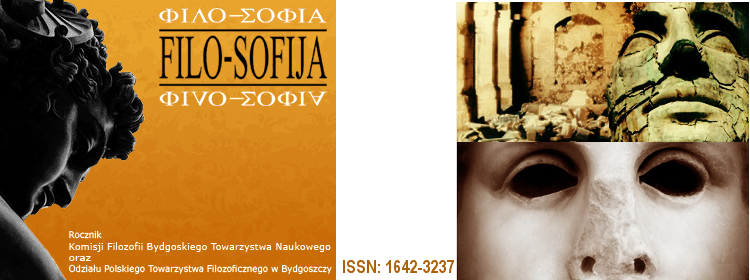NiebywaŇāe spojrzenie Apollina. Rainer Maria Rilke ‚Äď ‚Äěogromne hiperbole sztuki‚ÄĚ jako Ňļr√≥dŇāowoŇõńá tw√≥rczej przemiany
Abstract
The Unusual Gaze of Apollo. Rainer Maria Rilke ‚Äď the ‚ÄúGreat Hyperboles of Art‚ÄĚ as the Sourceness of Creative Transformation
The author of the sketch aims to present the role of creative experience in the aesthetic thought and poems of Rainer Maria Rilke. According to the author, this experience is the foundation of the poet's creative task and an important theme in his poetry. The centre of this experience is what the author calls creative transformation. He attempts to define its nature, stressing that it is tied to the symbol of the source. He introduces the distinction into traits and instants into the creative characteristic. The traits take root in the very experience of it, whereas instants relate to the reflective approach to it.
In the first two sections, the author engages in a reflection upon the poet's aesthetic thought found in his letters and in his book on Auguste Rodin. This leads to the conclusion that the poet indicates three instants of creative transformation: the secret life of the works of art, the self-creation of the works, and the transformation of the subject.
The second section is focused on two poems by Rilke, the ‚ÄúArchaic Torso of Apollo‚ÄĚ and ‚ÄúMusic‚ÄĚ. The author demonstrates that, in parallel to the instants above, the three main traits of the experience of creative transformation are expressed in them. He uncovers and reveals significant links between these contexts, that is, the instants of creative transformation in aesthetic thought and the hidden traits of this transformation in Rilke‚Äôs poetry. He also discovers a fourth trait of the experience of this transformation in the ‚ÄúMusic‚ÄĚ poem, which he construes as the maximally transcending opening. It encompasses and permeates its whole sourceness sphere, and therefore is the deepest foundation of its remaining traits and reflective instants.
In the conclusion, the author states that this sourceness sphere shows the dynamics of the poet's creative process. It can be called the dynamics of becoming through the source. It means there is a hidden pulse of a creative source. It is in the dynamics of creative transformation that the ‚Äúgreat hyperboles of art‚ÄĚ, described by Rilke, are seen.
Key words: Rainer Maria Rilke, August Rodin, creative experience, creative transformation, creative source, sourceness of the creative transformation, trait of creative transformation, instant of creative transformation, sphere of creative transformation.
The author of the sketch aims to present the role of creative experience in the aesthetic thought and poems of Rainer Maria Rilke. According to the author, this experience is the foundation of the poet's creative task and an important theme in his poetry. The centre of this experience is what the author calls creative transformation. He attempts to define its nature, stressing that it is tied to the symbol of the source. He introduces the distinction into traits and instants into the creative characteristic. The traits take root in the very experience of it, whereas instants relate to the reflective approach to it.
In the first two sections, the author engages in a reflection upon the poet's aesthetic thought found in his letters and in his book on Auguste Rodin. This leads to the conclusion that the poet indicates three instants of creative transformation: the secret life of the works of art, the self-creation of the works, and the transformation of the subject.
The second section is focused on two poems by Rilke, the ‚ÄúArchaic Torso of Apollo‚ÄĚ and ‚ÄúMusic‚ÄĚ. The author demonstrates that, in parallel to the instants above, the three main traits of the experience of creative transformation are expressed in them. He uncovers and reveals significant links between these contexts, that is, the instants of creative transformation in aesthetic thought and the hidden traits of this transformation in Rilke‚Äôs poetry. He also discovers a fourth trait of the experience of this transformation in the ‚ÄúMusic‚ÄĚ poem, which he construes as the maximally transcending opening. It encompasses and permeates its whole sourceness sphere, and therefore is the deepest foundation of its remaining traits and reflective instants.
In the conclusion, the author states that this sourceness sphere shows the dynamics of the poet's creative process. It can be called the dynamics of becoming through the source. It means there is a hidden pulse of a creative source. It is in the dynamics of creative transformation that the ‚Äúgreat hyperboles of art‚ÄĚ, described by Rilke, are seen.
Key words: Rainer Maria Rilke, August Rodin, creative experience, creative transformation, creative source, sourceness of the creative transformation, trait of creative transformation, instant of creative transformation, sphere of creative transformation.
PeŇāny tekst:
PDFAdministracja Cytowania | Strony czasopism
